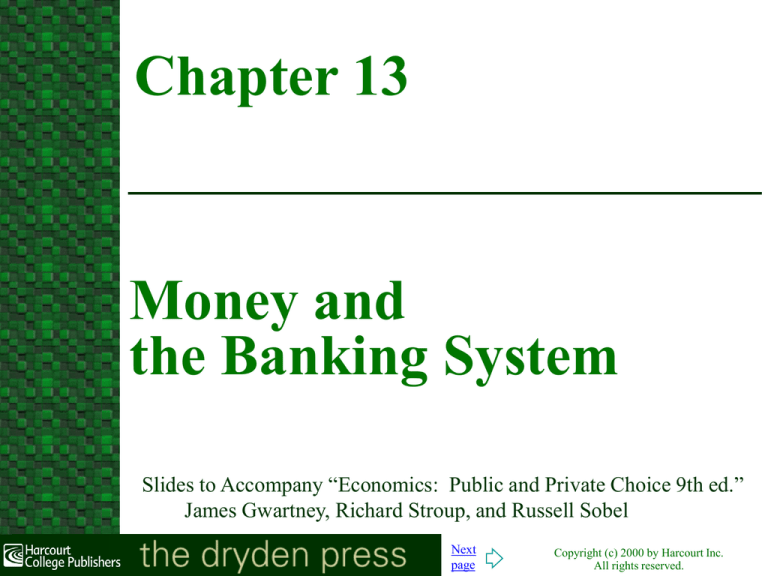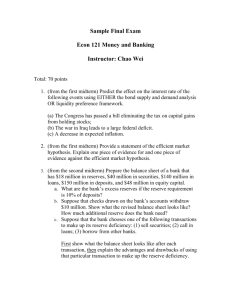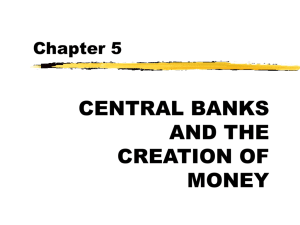
Chapter 13
Money and
the Banking System
Slides to Accompany “Economics: Public and Private Choice 9th ed.”
James Gwartney, Richard Stroup, and Russell Sobel
Next
page
Copyright (c) 2000 by Harcourt Inc.
All rights reserved.
“Money is whatever is generally accepted in
exchange for goods and services—accepted
not as an object to be consumed but as an
object that represents a temporary abode of
purchasing power to be used for buying still
other goods and services.”
-- Milton Friedman
Jump to first page
Copyright (c) 2000 by Harcourt Inc.
All rights reserved.
1. What Is Money?
Jump to first page
Copyright (c) 2000 by Harcourt Inc.
All rights reserved.
What Is Money?
A Medium of Exchange
-- An asset that is used to buy and sell
goods & services.
A Store of Value
-- An asset that will allow people to transfer
purchasing power from one period to another.
A Unit of Account
-- The units of measurement used by people to
post prices and keep track of revenues and costs.
Jump to first page
Copyright (c) 2000 by Harcourt Inc.
All rights reserved.
2. Why Is
Money Valuable?
Jump to first page
Copyright (c) 2000 by Harcourt Inc.
All rights reserved.
Why Is Money Valuable?
The main thing that makes money valuable is
the same thing that generates value for other
commodities:
The demand (for money) relative to its supply.
People demand money because it reduces the
cost of exchange.
When the supply of money is limited relative
to the demand, money will be valuable.
Jump to first page
Copyright (c) 2000 by Harcourt Inc.
All rights reserved.
3. The Supply
of Money
Jump to first page
Copyright (c) 2000 by Harcourt Inc.
All rights reserved.
The Supply of Money
The components of the M1 money supply are:
Currency
Checking Deposits (including demand deposits
and interest-earning checking deposits)
Traveler's checks
The M2 money supply is a broader measure
that includes:
M1,
Savings,
Time deposits, and,
Money mutual funds.
Jump to first page
Copyright (c) 2000 by Harcourt Inc.
All rights reserved.
Credit Cards
Versus Money
Money is an asset.
The use of a credit card is merely a
convenient way to arrange for a loan.
Credit card balances are a liability.
Thus, credit card purchases are not
money.
Jump to first page
Copyright (c) 2000 by Harcourt Inc.
All rights reserved.
4. The Business
of Banking
Jump to first page
Copyright (c) 2000 by Harcourt Inc.
All rights reserved.
The Business of Banking
The banking industry includes:
Banks accept deposits and use part of
them to extend loans and make investments.
Banks are profit-seeking institutions.
Banks play a central role in the capital
(loanable funds) market:
savings and loans,
credit unions, and,
commercial banks.
They help to bring together people who want to
save for the future with those who want to borrow
in order to undertake investment projects.
The banking system is a fractional reserve system:
-- Banks maintain only a fraction of their assets in
reserves to meet the requirements of depositors.
Jump to first page
Copyright (c) 2000 by Harcourt Inc.
All rights reserved.
Functions of Commercial
Banking Institutions
Consolidated Balance Sheet Of Commercial Banking Institutions,
Year-end 1998 (Billions Of Dollars)
ASSETS
Vault cash
Reserves at the Fed
Loans outstanding
U.S. government securities
Other securities
Other assets
Total
LIABILITIES
$
36
9
3,316
793
443
690
Transaction deposits
Savings and time deposits
Borrowings
Other liabilities
Net worth
$ 5,287
$ 665
2,656
985
560
421
$ 5,287
Banks provide services and pay interest to attract transaction
(checking), saving, and time deposits (liabilities).
Most of the deposits are invested and loaned out, providing
interest income for the bank.
Banks hold a portion of their assets as reserves (either as cash
or deposits with the Fed) to meet their daily obligations toward
their depositors.
Jump to first page
Copyright (c) 2000 by Harcourt Inc.
All rights reserved.
5. How Banks
Create Money by
Extending Loans
Jump to first page
Copyright (c) 2000 by Harcourt Inc.
All rights reserved.
How Banks Create Money by
Extending Loans
Under a fractional reserve system, an increase in
reserves will permit banks to extend additional loans
and thereby expand the money supply (create additional
checking deposits).
Bank
New Cash Deposits:
Actual Reserves
New Required
Reserves
Initial deposit (Bank A)
Second stage (Bank B)
Third stage (Bank C)
Fourth stage (Bank D)
Fifth stage (Bank E)
Sixth stage (Bank F)
Seventh stage (Bank G)
All others (other banks)
Total
$1,000.00
800.00
640.00
512.00
409.60
327.68
262.14
1,048.58
$5,000.00
$200.00
160.00
128.00
102.40
81.92
65.54
52.43
209.71
$1,000.00
Potential Demand Deposits
Created By Extending New Loans
$800.00
640.00
512.00
409.60
327.68
262.14
209.71
838.87
$4,000.00
When banks are required to maintain 20% reserves
against demand deposits, the creation of $1,000 of
new reserves will potentially increase the supply of
money by $5,000.
Jump to first page
Copyright (c) 2000 by Harcourt Inc.
All rights reserved.
How Banks Create Money
by Extending Loans
The lower the percentage of the reserve
requirement, the greater is the potential
expansion in the money supply resulting
from the creation of new reserves.
The fractional reserve requirement places a
ceiling on potential money creation from
new reserves.
The actual deposit multiplier will be less than
the potential because:
Some persons will hold currency rather than
bank deposits.
Some banks may not use all their excess
reserves to extend loans.
Jump to first page
Copyright (c) 2000 by Harcourt Inc.
All rights reserved.
Questions for Thought:
1. “People are poor because they don’t have very
much money. Yet, central bankers keep money
scarce. If people had more money, poverty
could be eliminated.” Do you agree with this
view? Why or why not?
2. What is a fractional reserve banking system?
How does it influence the ability of banks to
create money? Is it likely that banks will hold
excess reserves? Why or why not?
3. Suppose you withdraw $100 from your checking
account. How does this transaction affect
(a) the supply of money,
(b) the reserves of your bank, and,
(c) the excess reserves of your bank?
Jump to first page
Copyright (c) 2000 by Harcourt Inc.
All rights reserved.
6. The Federal
Reserve System
Jump to first page
Copyright (c) 2000 by Harcourt Inc.
All rights reserved.
The Federal
Reserve System
• The Fed is the central bank of
the U.S., responsible for the
conduct of monetary policy.
• The Fed is a ‘banker’s bank.’
• The Board of Governors of the
Federal Reserve is at the center
of the banking system in the U.S.
• The Board of Governors of the
Federal Reserve is at the center
of the banking system in the U.S.
• The board sets all the rates
and regulations for all
depository institutions.
Federal Reserve
Board of Governors
7 members appointed by
the president, with the
consent of the U.S. Senate
Open Market Committee
Federal Board of Governors
plus 5 Federal Reserve Bank
Presidents (alternating terms,
New York always represented)
Twelve Federal Reserve
District Banks
(25 branches)
Commercial Banks
Savings & Loan Associations
Credit Unions
Mutual Savings Banks
• The seven members of the Board
of Governors also serve on the
Federal Open Market Committee
• The FOMC is a 12-member
board that establishes Fed policy
with regard to the buying and
selling of govt. securities.
The Public:
Households and Businesses
Jump to first page
Copyright (c) 2000 by Harcourt Inc.
All rights reserved.
The Federal
Reserve System
The independence of the Federal Reserve
System strengthens its ability to pursue
long-term monetary policies.
This stems from:
the lengthy terms of the members of the Board
of Governors (14 years), and,
the fact that the Fed’s revenues are derived from
interest on the bonds that it holds rather than
allocations from Congress.
Jump to first page
Copyright (c) 2000 by Harcourt Inc.
All rights reserved.
The Federal Reserve Districts
Kansas City
Minneapolis
Chicago
1
9
Cleveland
2
7
3
12
San
Francisco
4
Boston
New York
Philadelphia
Washington, D.C.
(Board of Governors)
10
8
5
Richmond
Atlanta
6
11
St. Louis
Dallas
The map indicates the 12 Federal Reserve districts and the city
in which the district bank is located.
Each district bank monitors the commercial banks in their
region and assists them with the clearing of checks.
The Board of Governors of the Federal Reserve System is
located in Washington D.C.
Jump to first page
Copyright (c) 2000 by Harcourt Inc.
All rights reserved.
7. The Three Tools the
Fed Uses to Control
the Money Supply
Jump to first page
Copyright (c) 2000 by Harcourt Inc.
All rights reserved.
The Three Tools the Fed Uses
to Control the Money Supply
Reserve requirements:
-- a % of a specified liability category (for example
transaction accounts) that banking institutions
are required to hold as reserves against that type
of liability.
When the Fed lowers the required reserve
ratio, it creates excess reserves and allows
banks to extend additional loans, expanding
the money supply.
Raising the reserve requirements has the
opposite effect.
Jump to first page
Copyright (c) 2000 by Harcourt Inc.
All rights reserved.
The Three Tools the Fed Uses
to Control the Money Supply
Open Market Operations:
-- the buying and selling of U.S. Government securities
(national debt in the form of bonds) by the Fed.
This is the primary tool used by Fed.
When the Fed buys bonds the money supply
will expand, because:
the
bond buyers will acquire money, and,
bank reserves will increase, placing banks in a
position to expand the money supply through
the extension of additional loans.
When the Fed sells bonds the money supply
will contract because:
bond
buyers are giving up money in exchange
for securities, and,
the reserves available to banks will decline,
causing them to extend fewer loans.
Jump to first page
Copyright (c) 2000 by Harcourt Inc.
All rights reserved.
The Three Tools the Fed Uses
to Control the Money Supply
Discount Rate:
-- the interest rate the Fed charges banking
institutions for borrowed funds.
An increase in the discount rate is
restrictive (decreases the money supply)
because it discourages banks from
borrowing from the Federal Reserve to
extend new loans.
A reduction in the discount rate is
expansionary (increases the money supply)
because it makes borrowing from the
Federal Reserve less costly.
Jump to first page
Copyright (c) 2000 by Harcourt Inc.
All rights reserved.
Monetary Base and Money Supply
M1 = $1,076
Currency a
($434)
Checking deposits
($642)
$434
$47
monetary base = $481
(currency + bank reserves)
a Traveler’s checks are included in this category.
The monetary base (currency plus bank reserves) provides the
foundation for the money supply.
Currency in circulation contributes directly to the money supply . . .
while bank reserves provide the underpinnings for checking deposits.
Fed actions that alter the monetary base will affect the money supply:
By increasing reserve requirements, buying bonds, or increasing
the discount rate, the Fed can reduce the money supply.
By decreasing reserve requirements, selling bonds, or decreasing
the discount rate, the Fed can increase the money supply.
Jump to first page
Copyright (c) 2000 by Harcourt Inc.
All rights reserved.
8. The Difference
Between the Fed
and the Treasury
Jump to first page
Copyright (c) 2000 by Harcourt Inc.
All rights reserved.
The Difference Between
the Fed and the Treasury
The U.S. Treasury:
Is concerned with the finance of the federal
government.
Issues bonds to the general public to finance the
budget deficits of the federal government.
Does not determine the money supply.
The Federal Reserve:
Is concerned with the monetary climate for the
economy.
Does not issue bonds.
Determines the money supply
— primarily through its buying and selling
of bonds issued by the U.S. Treasury.
Jump to first page
Copyright (c) 2000 by Harcourt Inc.
All rights reserved.
9. Ambiguities in the
Meaning and
Measurement of
the Money Supply
Jump to first page
Copyright (c) 2000 by Harcourt Inc.
All rights reserved.
Ambiguities in the Meaning and
Measurement of the Money Supply
Interest earning checking deposits
Less costly to hold than currency and demand
deposits.
Their introduction in the early 1980’s changed
the nature of the M1 money supply.
Widespread use of the U.S. dollar outside of
the United States
More than one-half and perhaps as much as
two-thirds of U.S. currency is held overseas.
This reduces the reliability of the M1 money
supply measure.
Jump to first page
Copyright (c) 2000 by Harcourt Inc.
All rights reserved.
Ambiguities in the Meaning and
Measurement of the Money Supply
Sweeping of various interest-earning
checking accounts into Money Market
Deposit Accounts
The increasing availability of low-fee stock
and bond mutual funds
Debit Cards and Electronic Money
Summary:
Recent financial innovations and other
structural changes have blurred the meaning
of money and reduced the reliability of the
various money supply measures.
In the Computer-Age, continued change in
this area is likely.
Jump to first page
Copyright (c) 2000 by Harcourt Inc.
All rights reserved.
The Changing Nature of M1
Billions of
Dollars
Total =
$1,076
1200
M1
1050
$245
900
Interest-Earning
Checkable Deposits
750
$397
600
450
Demand Deposits
300
$434
150
Currencya
1975
1980
1985
1990
1995 1997
Year
As the result of deregulation during the 1980’s, interest earning
checkable deposits grew rapidly and they now account for
approximately one quarter of the M1 money supply.
Since the opportunity cost of holding these other checkable
deposits is less than for other forms of money, the money supply
today is not comparable to the money supply prior to 1980.
Jump to first page
Copyright (c) 2000 by Harcourt Inc.
All rights reserved.
The Growth Rate of the M1 and M2
Money Supply: 1970-1998
Annual Percentage
Change
15
M1
M2
10
5
0
Year
-5
1970
1975
1980
1985
1990
1995
2000
Here we present the annual growth rates for both the
M1 and M2 money supply figures.
Since the mid-1980’s, the variability of the M1 supply
has been much greater than that for M2 due greatly to
the regulatory changes and innovations in financial
markets that have changed the very nature of M1.
Jump to first page
Copyright (c) 2000 by Harcourt Inc.
All rights reserved.
Questions for Thought:
1. How will the following actions affect the money supply?
(a) A reduction in the discount rate.
(b) An increase in the reserve requirements.
(c) The purchase by the Fed of $100 million
of U.S. securities from a commercial bank.
(d) The sale by the U.S. Treasury of $100 million
of newly issued bonds to a commercial bank.
(e) An increase in the discount rate.
(f) The sale by the Fed of $200 million of U.S.
securities to a private investor.
2. How has the nature of the M1 money supply changed in
recent years? How have these changes influenced the
usefulness of M1 as an indicator of monetary policy?
3. Who is the current chairman of the Board of Governors
of the Fed?
Jump to first page
Copyright (c) 2000 by Harcourt Inc.
All rights reserved.
End
Chapter 13
Jump to first page
Copyright (c) 2000 by Harcourt Inc.
All rights reserved.









